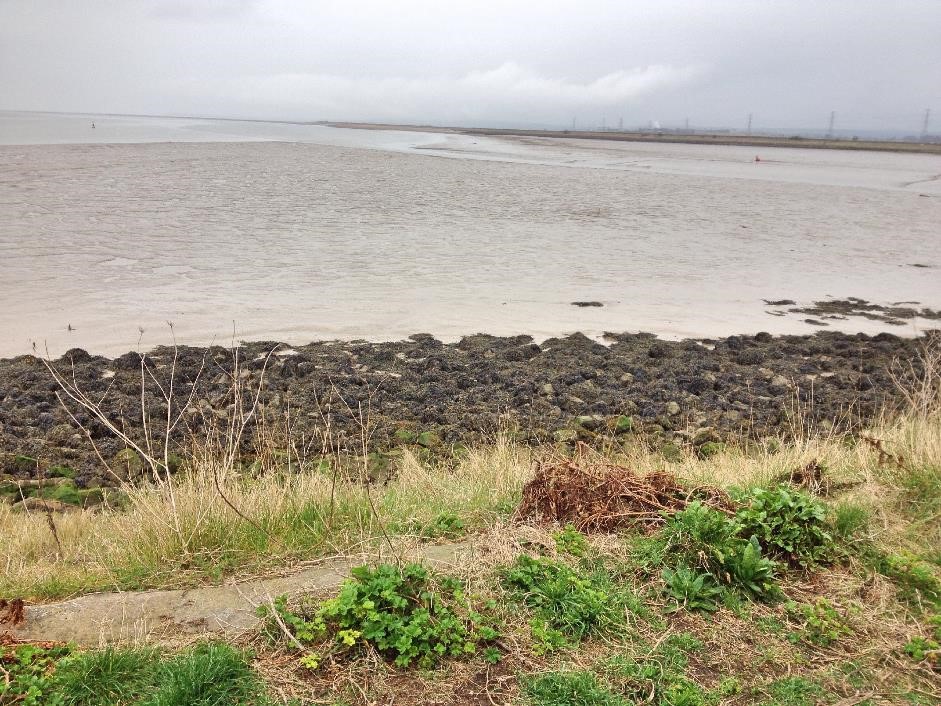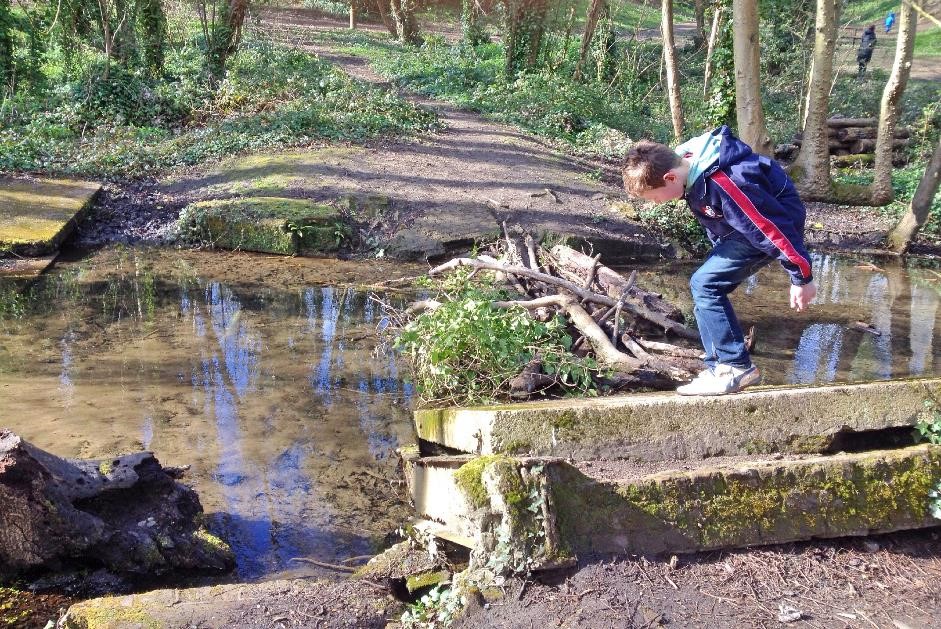The image above sums up our introduction to Faversham in North Kent. We arrived on a miserable day and after dropping off our luggage headed to the local nature reserve to stretch our legs. Contrary to what you may think I rather like the bleakness of the mudflats against the grey sky.
Faversham may not be an obvious tourist destination but it has an interesting history. In particular it was home to the first gunpowder plant in the country, an industry that featured in most of our walks.
Oare Marshes Nature Reserve
Oare Marshes Nature Reserve comprises an area of saltmarsh, mudflats and reed beds. We followed part of the nature trail from the visitor centre along to the hide where we stopped to look for birds. The track forms part of a 2km route around the reserve and is perfect for a short evening walk.

There are good views over to the Isle of Sheppey which looks tantalisingly close across the Swale Estuary. At one time a ferry operated to the island from the causeway but nowadays it’s a 45 minute detour by road.

The tide was out so we watched the birds wading through the mudflats. I’m no expert, but my other half informs me they included curlew, avocet, redshank and shoveler ducks.

It’s hard to believe but this peaceful place was once home to a gunpowder factory. In 1916 a huge explosion occurred at the nearby Guncotton factory in Uplees which killed more than 100 men and boys. Despite being heard as far away as Norwich the explosion was kept secret for several weeks, presumably due to the ongoing war. Much of the factory that once stood on this marsh was destroyed although there are still remnants of concrete bases in the grassland.
Gunpowder Works Country Park
This is a small reserve that’s full of interest. As its name indicates it is sited on the remains of a former gunpowder factory. The park contains relics from it’s industrial past, including parts of the mills and the leats (canals created to enable movement of gunpowder around the site).

Gunpowder was produced here until the 1930s when the site was closed and left to nature for more than 70 years. Nowadays the woodland is managed and new structures such as a boardwalk across the marshland have been put in place.

There’s a small visitor centre based in the old cooperage, where the gunpowder barrels were once made. When it’s open you can find out more about the history of the site and pick up a walking trail leaflet. Walks around the park are colour coded; we chose the longest yellow circuit which took about an hour.

If you’re in the area on a weekend afternoon you can also visit Chart Gunpowder Mills. Situated in the middle of a housing estate you’ll find Faversham’s first gunpowder factory. It’s a fully working mill but given its location I assume they don’t manufacture the gunpowder!
Faversham town and creek
The town of Faversham is great for random wandering. We walked through the town, nosing at the various houses, along to Standard Quay. Whilst the area where the barges are moored is interesting, most of Standard Quay appears to be given over to antique shops.We’re not ‘antique tourists’ so carried on through to Iron Wharf. This is a working boatyard where you’ll find boats in all stages of repair.

We weren’t sure if we were supposed to be walking through as it’s a bit haphazard with rusting boats and containers stacked on top of each other. There’s a definite boating community feel to the area and lots of different vessels to look at. At the end of the boatyard there’s a small bridge that takes you out on to the marshes, and signs for the Saxon Shore Way which indicated we’d been on the right route. We turned back soon after, but if we’d felt energetic we could have walked all the way to Whitstable. Next time maybe!
More info:
- Oare Marshes Nature Reserve is open all year round. There’s no entrance charge.
- The Gunpowder Works Country Park is open from 9am-5pm daily. The visitor centre (where the only toilets are) is open from 10.30am-4.30pm at weekends between April-November.
- We didn’t follow a specific trail in Faversham but if you want to know what you’re actually looking at this walk looks perfect. It’s a flat 4 mile route through the town and along Faversham Creek.

Stunning photos, I must admit that the bad weather gives a moody edge to shots! The marshes looks like a wonderful spot – and I never knew that a gunpowder factory was destroyed in the area. It’s brilliant to discover more history in the countryside around us. And I love random wanderings, sometimes you find the best places.
Thanks Ting. What I didn’t realise at the time was that our accommodation in Uplees must have been near enough next to the gunpowder factories and the explosion.
This looks lovely – I’ve been to Whitstable before which is gorgeous but never Faversham. The walks and history are great though.
We went to Whitstable too. I had planned to stay there but left it rather late to book accommodation over Easter so we ended up staying on a sheep farm near Faversham. Lovely place and we coincided with lambing time.
You look like you had all the seasons in one day on that visit. Lovely day out, I too like bleakness sometimes #traveltales
I certainly wouldn’t have complained if it had been sunny and warm the whole visit, but I do think some landscapes demand bleak weather.
As always another interesting place to visit with the family as well as great for nature spotting. (I voted for you in the travel category)
Thank you for your kind comments Kriss, and for voting for me – that means a lot!
Hi Christine, whilst I wouldn’t want to wake up to that heavy greyness every morning I think it suits the mudflats. It gives them a very English look. And if it’s appealing when grey and overcast, then it must be doubly appealing when the sky is blue and the sun is shining!
Just getting out in nature and soaking up the history of the place would be appealing to me.
Yes, there’s a definite English look to the mudflats! Although I’m rather jealous of your Greek weather and island views….
I once went to Margate in terrible weather – windy and bleak. It wasn’t very good for a seaside holiday (to be fair, it was off season) but it was fascinating to discover that all those pictures Turner painted in the area of sandy coloured water where the wind whipped up the seabed were absolutely accurate rather than, as I had previously thought, the result of artistic licence. Faversham looks interesting. Must get down Kent way again soon.
Ah we didn’t visit Margate, I think I had too many preconceived ideas as to what it would be like. Although I imagine it’s different now that it’s been Tracey Emin’ed.
I love visiting Kent…there is so much more on offer than people think. great post #countrykids
I agree. It doesn’t really get the same holidaymaker attention that the south west does but it seems to have better weather (except when we visited!).
Wonderful scenery! I lived in Kent for year, though not by the coast. Such a beautiful county, so much to see and explore
I’ve only visited a couple of small parts of the county so I too have plenty to explore still.
How exciting walking where a gunpowder factory once stood! I bet you could almost smell it in the air! I think you can be a tourist just about anywhere and this post certainly proves that. Thanks for linking to #traveltales – I’ve pinned this post to our pinterest board. Hope to see you next month 😀 – Sam x
Thanks Sam. It was a little sad when you think about how many people died in the 1916 explosion, not even a kilometre from where we were staying.
Things you learn. I had no idea about all the old Gunpowder factories – let alone that one blew up!
Great photos, the Gunpowder Works Country Park looks lovely too, just my kind of place. I’ll have to remember this Park when I’m looking for somewhere new to explore during the summer 🙂
It never even occurred to me there would be gunpowder factories and mills up until so recently. Not sure how I thought it was made!